Validation of the Two Standard MODIS Satellite Burned-Area Products and an Empirically-Derived Merged Product in South Africa
Abstract
:1. Introduction
2. Study Area and Datasets
2.1. Description of Study Area
2.2. Ancillary Datasets Used
2.3. MODIS Burned Area Products
3. Methodology
3.1. Assessing the Error of MCD45A1 and MCD64A1 Products
3.2. Classification Error Assessment of the MCD45A1, MCD64A1 and Merged Products in Relation to the Fractional Sub-Pixel Burned Area
3.3. Analysis of Mean Percent Concurrence of Burned Pixels between MCD45A1 and MCD64A1 Products
4. Results
4.1. Assessing the Error of MCD45A1 and MCD64A1 Products
4.2. Classification Error Assessment of the MCD45A1, MCD64A1 and Merged Products in Relation to the Fractional Sub-Pixel Burned Area
4.3. Analysis of Mean Percent Concurrence of Burned Pixels between MCD45A1 and MCD64A1 Products
5. Discussion
6. Conclusions
Acknowledgments
Author Contributions
Conflicts of Interest
References
- Tansey, K.; Grégoire, J.; Stroppiana, D.; Sousa, A.; Silva, J.; Pereira, J.M.C.; Boschetti, L.; Maggi, M.; Brivio, P.A.; Fraser, R.; et al. Vegetation burning in the year 2000: Global burned area estimates from SPOT VEGETATION data. J. Geophys. Res 2004, 109, D14S03. [Google Scholar] [CrossRef]
- Loboda, T.V.; Csiszar, I.A. Estimating Burned Area from AVHRR and MODIS: Validation Results and Sources of Error. Proceedings of the 2nd Open All-Russia Conference: Current Aspects of Remote Sensing of Earth from Space, Moscow, Russia, 16–18 November 2004; pp. 415–421.
- Roy, D.P.; Jin, Y.; Lewis, P.E.; Justice, C.O. Prototyping a global algorithm for systematic fire-affected area mapping using MODIS time series data. Remote Sens. Environ 2005, 97, 137–162. [Google Scholar]
- Andreae, M.O. Biomass Burning: Its History, Use and Distribution and Its Impact on the Environmental Quality and Global Climate. In Global Biomass Burning; Levine, J.S., Ed.; MIT Press: Cambridge, MA, USA, 1991; pp. 3–21. [Google Scholar]
- Giglio, L.; Randerson, J.T.; van der Werf, G.R.; Kasibhatla, P.S.; Collatz, G.J.; Morton, D.C.; DeFries, R.S. Assessing variability and long-term trends in burned area by merging multiple satellite fire products. Biogeosciences 2010, 7, 1171–1186. [Google Scholar]
- Andreae, M.O.; Merlet, P. Emission of trace gases and aerosols from biomass burning. Glob. Biogeochem. Cy 2001, 15, 955–966. [Google Scholar]
- Van der Werf, G.R.; Randerson, J.T.; Giglio, L.; Collatz, G.J.; Mu, M.; Kasibhatla, P.S.; Morton, D.C.; DeFries, R.S.; Jin, Y.; van Leeuwen, T.T. Global fire emissions and the contribution of deforestation, savanna, forest, agricultural, and peat fires (1997–2009). Atmos. Chem. Phys. Discuss 2010, 10, 16153–16230. [Google Scholar]
- Giglio, L.; Justice, C.O. Effect of wavelength selection on characterization of fire size and temperature. Int. J. Remote Sens 2003, 24, 3515–3520. [Google Scholar]
- Giglio, L.; Loboda, T.; Roy, D.P.; Quayle, B.; Justice, C.O. An active-fire based burned area mapping algorithm for the MODIS sensor. Remote Sens. Environ 2009, 113, 408–420. [Google Scholar]
- Eva, H.; Lambin, E.F. Fires and land-cover change in the tropics: A remote sensing analysis at the landscape scale. J. Biogeogr 2000, 27, 765–776. [Google Scholar]
- Plummer, S.; Arino, O.; Simon, M.; Steffen, W. Establishing an earth observation product service for the terrestrial carbon community: The globcarbon initiative. Mitig. Adapt. Strateg. Glob. Chang 2006, 11, 97–111. [Google Scholar]
- Tansey, K.; Grégoire, J.-M.; Defourny, P.; Leigh, R.; Pekel, J.-F.; van Bogaert, E.; Bartholomé, E. A new, global, multi-annual (2000–2007) burnt area product at 1 km resolution. Geophys. Res. Lett 2008, 35. [Google Scholar] [CrossRef]
- Roy, D.P.; Boschetti, L.; Justice, C.O.; Ju, J. The collection 5 MODIS burned area product—Global evaluation by comparison with the MODIS active fire product. Remote Sens. Environ 2008, 112, 3690–3707. [Google Scholar]
- Oliva, P.; Martín, P.; Chuvieco, E. Burned area mapping with MERIS post-fire image. Int. J. Remote Sens 2011, 32, 4175–4201. [Google Scholar]
- Chuvieco, E.; Martín, M.P.; Palacios, A. Assessment of different spectral indices in the red-near-infrared spectral domain for burned land discrimination. Int. J. Remote Sens 2002, 23, 5103–5110. [Google Scholar]
- Silva, J.M.N.; Sá, A.C.L.; Pereira, J.M.C. Comparison of burned area estimates derived from SPOT-VEGETATION and Landsat ETM+ data in Africa: Influence of spatial pattern and vegetation type. Remote Sens. Environ 2005, 96, 188–201. [Google Scholar]
- Boschetti, L.; Brivio, P.A.; Eva, H.D.; Gallego, J.; Baraldi, A.; Grégoire, J.-M. A sampling method for the retrospective validation of global burned area products. IEEE Trans. Geosci. Remote Sens 2006, 44, 1765–1772. [Google Scholar]
- Sá, A.C.L.; Pereira, J.M.C.; Gardner, R.H. Analysis of the relationship between spatial pattern and spectral detectability of areas burned in Southern Africa using satellite data. Int. J. Remote Sens 2007, 28, 3583–3601. [Google Scholar]
- Roy, D.P.; Boschetti, L. Southern Africa validation of the MODIS, L3JRC, and GlobCarbon burned-area products. IEEE Trans. Geosci. Remote Sens 2009, 47, 1032–1044. [Google Scholar]
- Tsela, P.L.; van Helden, P.; Frost, P.; Wessels, K.; Archibald, S. Validation of the MODIS Burned-Area Products Across Different Biomes in South Africa. Proceedings of the IEEE International Geoscience and Remote Sensing Symposium (IGARSS), Honolulu, HI, USA, 25–30 July 2010; pp. 3652–3655.
- De Klerk, H.M.; Wilson, A.M.; Steenkamp, K. Evaluation of satellite-derived burned area products for the fynbos, a Mediterranean shrubland. Int. J. Wildland Fire 2012, 21, 36–47. [Google Scholar]
- Roy, D.P.; Trigg, S.N.; Bhima, R.; Brockett, B.H.; Dube, O.P.; Frost, P.; Govender, N.; Landmann, T.; Le Roux, J.; Lepono, T.; et al. The utility of satellite fire product accuracy information-perspectives and recommendations from the Southern Africa fire network. IEEE Trans. Geosci. Remote Sens 2006, 44, 1928–1930. [Google Scholar]
- University of Maryland. MODIS Collection 5 Active Fire Product User’s Guide; 2010. Available online: http://modisfire.umd.edu/documents/MODIS_Fire_Users_Guide_2.4.pdf (accessed on 10 March 2012).
- Mucina, L.; Rutherford, M.C. The Vegetation of South Africa, Lesotho and Swaziland; South African National Biodiversity Institute: Pretoria, South Africa, 2006. [Google Scholar]
- Thompson, M. A standard land-cover classification scheme for remote-sensing applications in South Africa. S. Afr. J. Sci 1996, 92, 34–42. [Google Scholar]
- Fairbanks, D.H.K.; Thompson, M.W.; Vink, D.E.; Newby, T.S.; van den Berg, H.M.; Everard, D.A. The South African land-cover characteristics database: A synopsis of the landscape. S. Afr. J. Sci 2000, 96, 69–80. [Google Scholar]
- Huffman, G.J.; Adler, R.F.; Rudolf, B.; Schneider, U.; Keehn, P.R. Global precipitation estimates based on a technique for combining satellite-based estimates, rain gauge analysis, and NWP model precipitation information. J. Clim 1995, 8, 1284–1295. [Google Scholar]
- Huffman, G.J.; Adler, R.F.; Bolvin, D.T.; Gu, G.; Nelkin, E.J.; Bowman, K.P.; Gu, G.; Hong, Y.; Bowman, K.P.; Stocker, E.F. The TRMM Multisatellite Precipitation Analysis (TMPA): Quasi-global, multiyear, combined-sensor precipitation estimates at fine scales. J. Hydrometeorol 2007, 8, 38–55. [Google Scholar]
- Wessels, K.; Steenkamp, K.; von Maltitz, G.; Archibald, S. Remotely sensed vegetation phenology for describing and predicting the biomes of South Africa. Appl. Veg. Sci 2011, 14, 49–66. [Google Scholar]
- Kraaij, T. Changing the fire management regime in the renosterveld and lowland fynbos of the Bontebok National Park. S. Afr. J. Bot 2010, 76, 550–557. [Google Scholar]
- Roy, D.P.; Frost, P.G.H.; Justice, C.O.; Landmann, T.; Le Roux, J.L.; Gumbo, K.; Makungwa, S.; Dunham, K.; Du Toit, R.; Mhwandagara, K.; et al. The Southern Africa Fire Network (SAFNet) regional burned-area product-validation protocol. Int. J. Remote Sens 2005, 26, 4265–4292. [Google Scholar]
- Vermote, E.F.; El Saleous, N.Z.; Justice, C.O. Operational atmospheric correction of the MODIS data in the visible to middle infrared: First results. Remote Sens. Environ 2002, 83, 97–111. [Google Scholar]
- Congalton, R.G. A review of assessing the accuracy of classifications of remotely sensed data. Remote Sens. Environ 1991, 37, 35–46. [Google Scholar]
- Boschetti, L.; Flasse, S.P.; Brivio, P.A. Analysis of the conflict between omission and commission in low spatial resolution dichotomic thematic products: The Pareto Boundary. Remote Sens. Environ 2004, 91, 280–292. [Google Scholar]
- Foody, G. Harshness in image classification accuracy assessment. Int. J. Remote Sens 2008, 29, 3137–3158. [Google Scholar]
- Eva, H.; Lambin, E.F. Burnt area mapping in Central Africa using ATSR data. Int. J. Remote Sens 1998, 19, 3473–3497. [Google Scholar]
- Eva, H.; Lambin, E.F. Remote sensing of biomass burning in tropical regions: Sampling issues and multisensor approach. Remote Sens. Environ 1998, 64, 292–315. [Google Scholar]
- Miettinen, J. Burnt Area Mapping in Insular Southeast Asia Using Medium Resolution Satellite Imagery. University of Helsinki, Helsinki, Finland, 2007. [Google Scholar]
- Roy, D.P.; Lewis, P.E.; Justice, C.O. Burned area mapping using multi-temporal moderate spatial resolution data—A bi-directional reflectance model-based expectation approach. Remote Sens. Environ 2002, 83, 263–286. [Google Scholar]
- Roy, D.P. Geographic Information Science Center of Excellence; South Dakota State University: Brookings, SD, USA, Oral Communication,; 18 July 2012. [Google Scholar]
- Dempewolf, J.; Trigg, S.; DeFries, R.S.; Eby, S. Burned-area mapping of the Serengeti-Mara region using MODIS reflectance data. IEEE Geosci. Remote Sens. Lett 2007, 4, 312–316. [Google Scholar]
- Bastarrika, A.; Chuvieco, E.; Martin, M.P. Automatic burned land mapping from MODIS time series images: Assessment in Mediterranean ecosystems. IEEE Trans. Geosci. Remote Sens 2011, 49, 3401–3413. [Google Scholar]
- Levin, N.; Heimowitz, A. Mapping spatial and temporal patterns of Mediterranean wildfires from MODIS. Remote Sens. Environ 2012, 126, 12–26. [Google Scholar]
- Bastarrika, A.; Chuvieco, E.; Martín, M.P. Mapping burned areas from Landsat TM/ETM+ data with a two-phase algorithm: Balancing omission and commission errors. Remote Sens. Environ 2011, 115, 1003–1012. [Google Scholar]
- Polychronaki, A.; Gitas, I.Z. Burned area mapping in Greece using SPOT-4 HRVIR images and object-based image analysis. Remote Sens 2012, 4, 424–438. [Google Scholar]
- Stroppiana, D.; Bordogna, G.; Carrara, P.; Boschetti, M.; Boschetti, L.; Brivio, P.A. A method for extracting burned areas from Landsat TM/ETM+ images by soft aggregation of multiple Spectral Indices and a region growing algorithm. ISPRS J. Photogramm. Remote Sens 2012, 69, 88–102. [Google Scholar]
- Koutsias, N.; Pleniou, M.; Mallinis, G.; Nioti, F.; Sifakis, N.I. A rule-based semi-automatic method to map burned areas: Exploring the USGS historical archives to reconstruct recent fire history. Int. J. Remote Sens 2013, 34, 7049–7068. [Google Scholar]

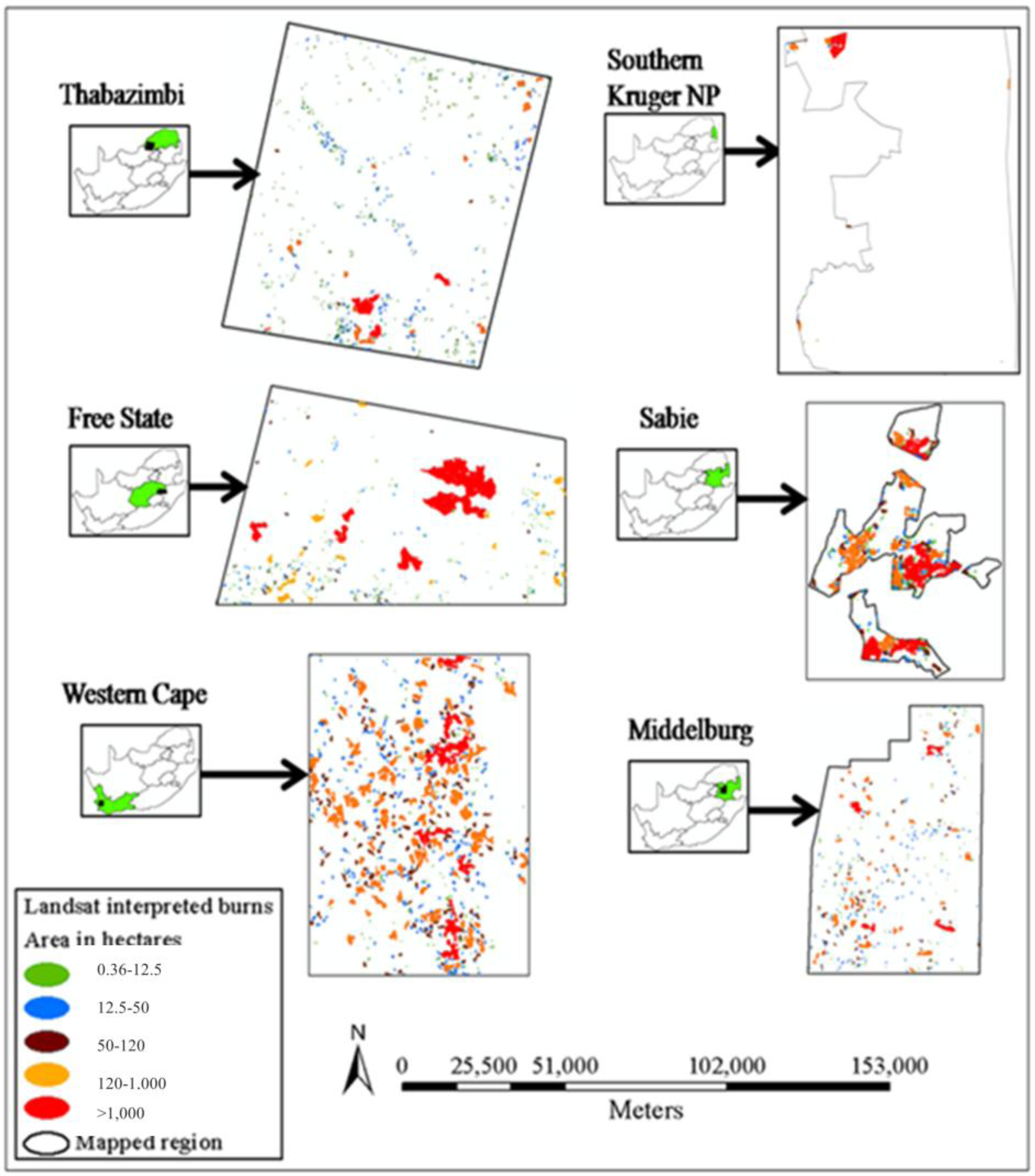
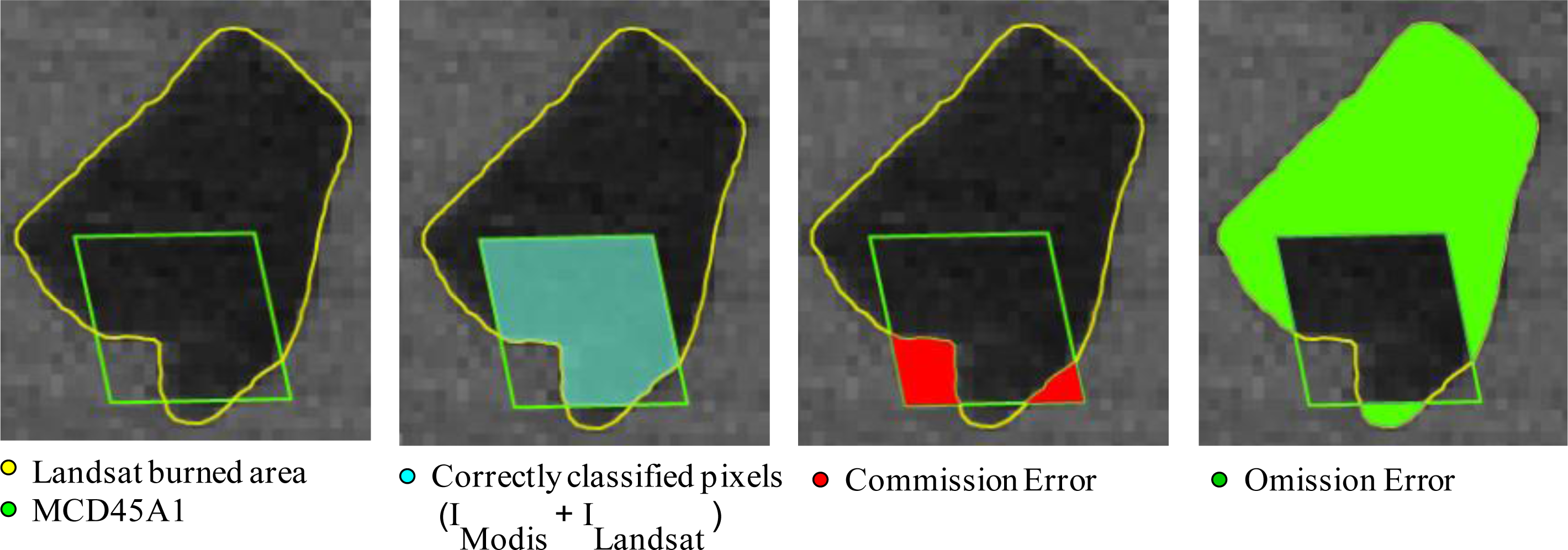
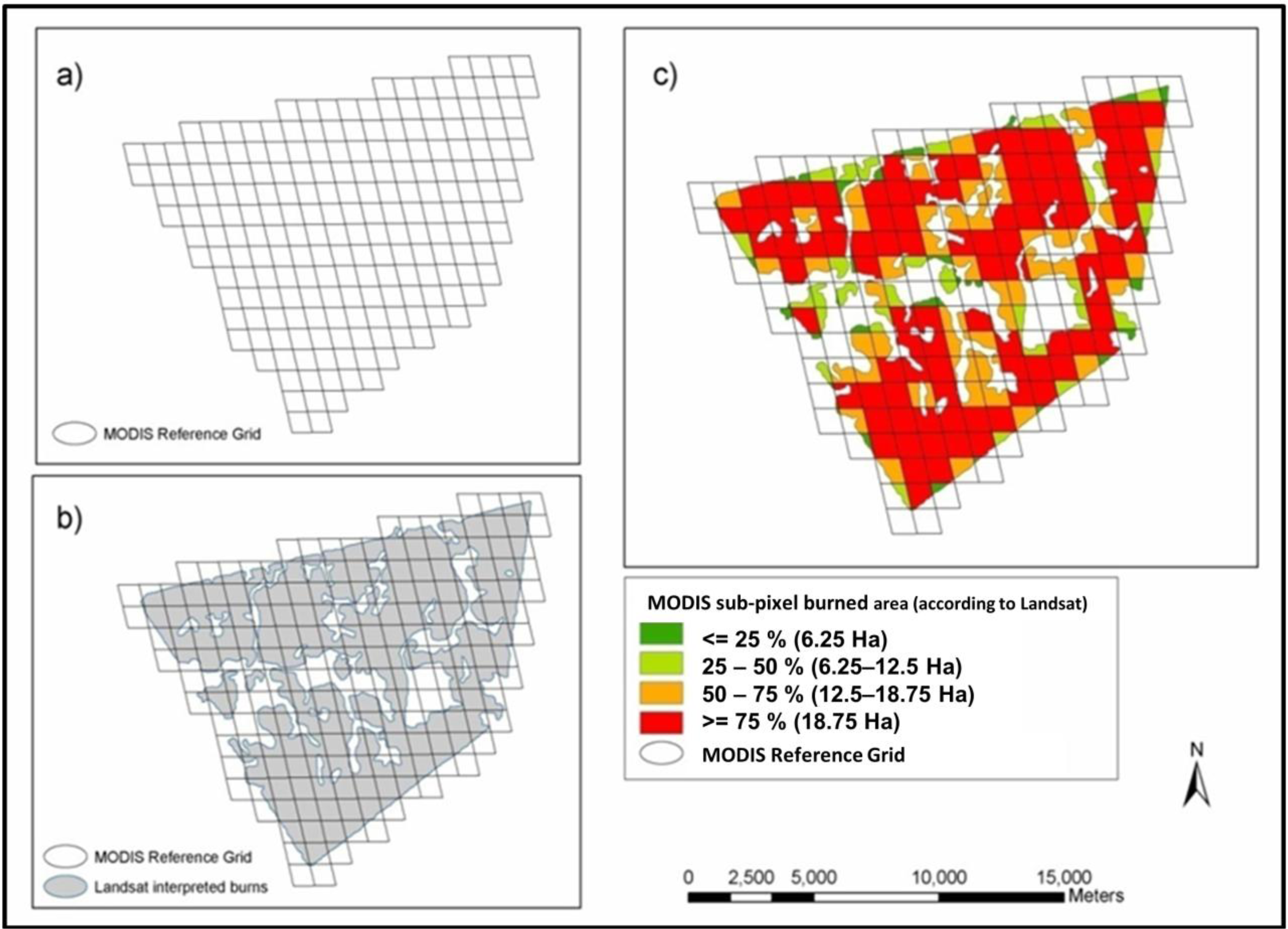

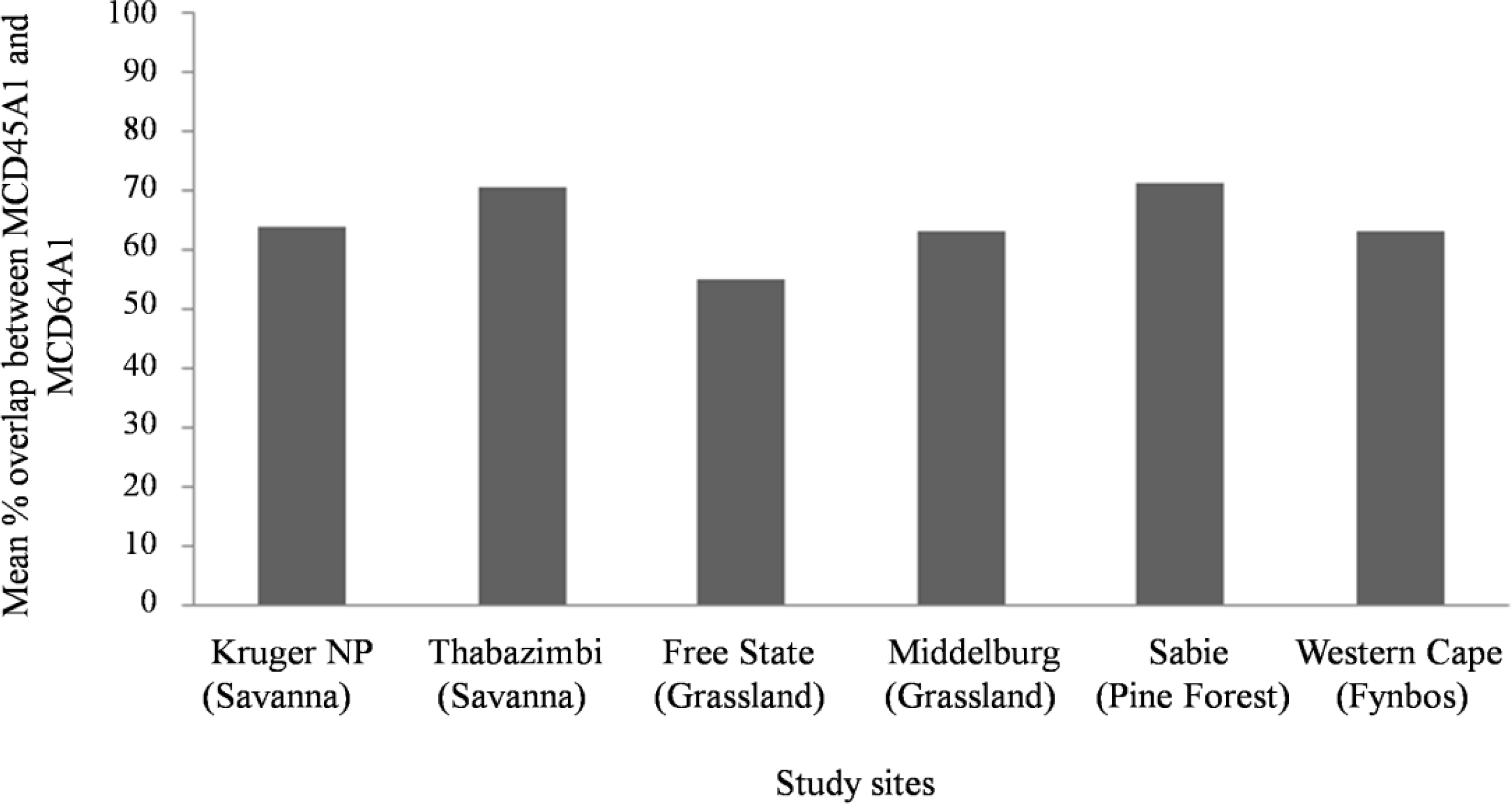
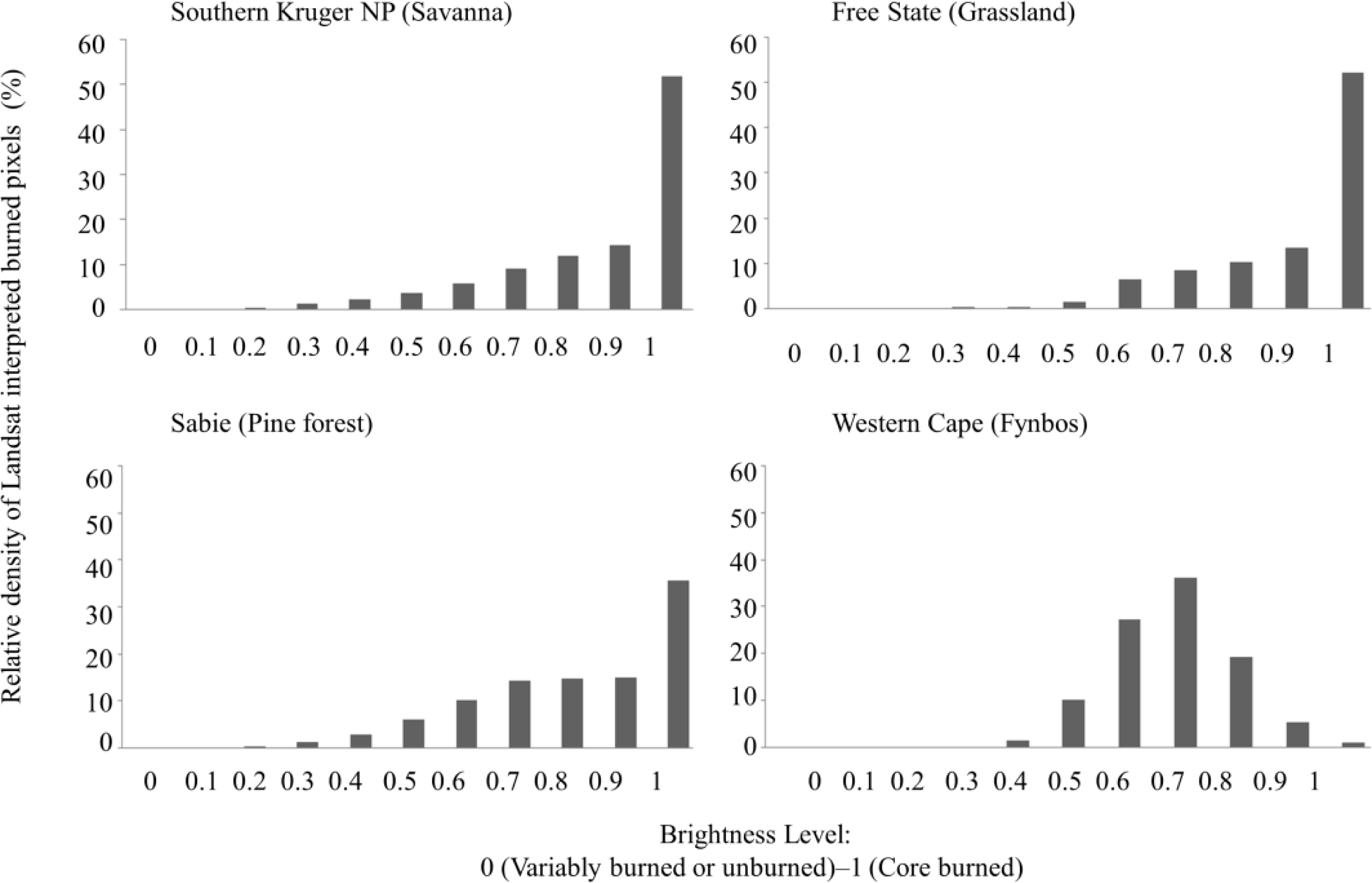
| # | Biome | Site, Landsat Path/Row | TM Dates 2007 | Mean Annual Rainfall (mm) | Selected Biome Characteristics [29] |
|---|---|---|---|---|---|
| 1. | Savanna | Southern Kruger National Park (NP) 168/077 | 11 August 27 August | 610–859 | Mostly arid woodland characterized by Combretum spp./Terminalia sericea; open tree savanna (Sclerocarya birrea) and thickets associated with high intensity fires |
| 2. | Grassland | Middelburg 169/078 | 18 August 3 September | 609–812 | Predominated by a single layer of grasses (i.e., sour grasses); associated with frequent and extreme fires; sparse trees/woody plants |
| 3. | Fynbos | Western Cape 175/083 | 17 February 6 April | 260–504 | Generally comprised of fine-leaved low shrubs; mostly mountainous and highly flammable |
| 4. | Pine forest | Sabie 169/077 | 15 June 18 August | 569–810 | Characterized by forest mountain ranges and expansive valleys; located in the areas of extreme vegetation fire risk and wind driven flames |
| 5. | Savanna | Thabazimbi 171/077 | 15 July 16 August | 458–624 | Generally occupied by moist woodland savanna; distributed tall grasses and trees; extremely high-intensity fires |
| 6. | Grassland | Free State 169/080 | 18 August 3 September | 814–975 | Covered by a dense layer of grassland (i.e., sweet grassland); high rainfall; rapid fuel biomass accumulation; high-intensity fires |
| MODIS Tiles | h20v11 | h20v12 | h19v11 | h19v12 | ||||
|---|---|---|---|---|---|---|---|---|
| Temporal Separation of Burn Dates in Days (n) | No. of Pixels | % | No. of Pixels | % | No. of Pixels | % | No. of Pixels | % |
| 0 | 601,038 | 27.01 | 66,653 | 24.78 | 67,101 | 29.97 | 5,412 | 18.36 |
| 1 | 835,732 | 37.56 | 88,707 | 32.98 | 94,874 | 42.38 | 9,651 | 32.74 |
| 2 | 390,390 | 17.55 | 48,005 | 17.85 | 39,027 | 17.43 | 5,865 | 19.9 |
| 3 | 187,105 | 8.41 | 26,654 | 9.91 | 13,957 | 6.23 | 3,634 | 12.33 |
| 4 | 90,855 | 4.08 | 15,055 | 5.6 | 5,245 | 2.34 | 2,234 | 7.58 |
| 5 | 50,190 | 2.26 | 9,579 | 3.56 | 1,999 | 0.89 | 1,273 | 4.32 |
| 6 | 27,674 | 1.24 | 5,496 | 2.04 | 863 | 0.39 | 711 | 2.41 |
| 7 | 16,882 | 0.76 | 3,191 | 1.19 | 495 | 0.22 | 446 | 1.51 |
| 8 | 10,090 | 0.45 | 1,943 | 0.72 | 300 | 0.13 | 250 | 0.85 |
| MCD45A1 | MCD64A1 | Concurrence (Binary AND) | Merge (Binary OR) |
|---|---|---|---|
| 1 | 0 | 0 | 1 |
| 1 | 1 | 1 | 1 |
| 0 | 1 | 0 | 1 |
| 0 | 0 | 0 | 0 |
| Total | 1 | 3 | |
| Site, Landsat Path/Row | Landsat Dates | Product | Percentage of Landsat Burns of Different Sizes Detected by MODIS Burned Area Products | Oe (%) | Ce (%) | |||
|---|---|---|---|---|---|---|---|---|
| <50 ha | 50–100 ha | >100–500 ha | >500 ha | |||||
| Southern Kruger NP (savanna) 168/077 | 8/11/2007 8/27/2007 | MCD45A1 | 17.65 | 66.67 | 75.00 | 100.00 | 56.47 | 34.42 |
| MCD64A1 | 5.88 | 66.67 | 75.00 | 100.00 | 60.70 | 20.41 | ||
| Thabazimbi (savanna) 171/077 | 7/15/2007 8/16/2007 | MCD45A1 | 0.00 | 0.00 | 31.25 | 100.00 | 89.58 | 12.68 |
| MCD64A1 | 0.12 | 0.00 | 31.25 | 87.50 | 89.45 | 11.53 | ||
| Free State (grassland) 169/080 | 8/18/2007 9/3/2007 | MCD45A1 | 3.36 | 37.04 | 89.29 | 100.00 | 43.81 | 27.02 |
| MCD64A1 | 1.68 | 3.70 | 57.14 | 100.00 | 48.30 | 20.85 | ||
| Middelburg (grassland) 169/078 | 8/18/2007 9/3/2007 | MCD45A1 | 1.39 | 16.67 | 67.57 | 100.00 | 81.30 | 35.97 |
| MCD64A1 | 0.28 | 0.00 | 43.24 | 100.00 | 83.82 | 25.14 | ||
| Western Cape (fynbos) 175/083 | 2/17/2007 4/6/2007 | MCD45A1 | 1.92 | 9.57 | 31.86 | 69.57 | 87.52 | 23.36 |
| MCD64A1 | 0.72 | 6.96 | 29.20 | 69.57 | 90.48 | 17.64 | ||
| Sabie (pine forest) 169/077 | 6/15/2007 8/18/2007 | MCD45A1 | 16.34 | 30.00 | 46.67 | 100.00 | 80.50 | 26.09 |
| MCD64A1 | 66.54 | 60.00 | 100.00 | 100.00 | 38.50 | 40.35 | ||
| Site, Landsat Path/Row | Landsat Dates | Product | MODIS Pixels ≥50% Burned | MODIS Pixels ≥75% Burned | ||
|---|---|---|---|---|---|---|
| Oe (%) | Ce (%) | Oe (%) | Ce (%) | |||
| Southern Kruger NP (savanna) 168/077 | 8/11/2007 8/27/2007 | MCD45A1 | 36.22 | 26.27 | 26.83 | 30.47 |
| MCD64A1 | 34.05 | 16.59 | 25.20 | 23.66 | ||
| Merged | 22.70 | 24.88 | 17.07 | 34.05 | ||
| Thabazimbi (savanna) 171/077 | 7/15/2007 8/16/2007 | MCD45A1 | 55.62 | 0.88 | 41.03 | 1.65 |
| MCD64A1 | 54.11 | 0.62 | 39.20 | 1.47 | ||
| Merged | 46.47 | 1.33 | 30.40 | 2.52 | ||
| Free State (grassland) 169/080 | 8/18/2007 9/3/2007 | MCD45A1 | 11.08 | 19.89 | 5.23 | 27.56 |
| MCD64A1 | 14.33 | 14.00 | 6.99 | 21.03 | ||
| Merged | 9.89 | 21.38 | 4.05 | 29.01 | ||
| Middelburg (grassland) 169/078 | 8/18/2007 9/3/2007 | MCD45A1 | 50.74 | 5.54 | 37.67 | 8.93 |
| MCD64A1 | 54.47 | 3.53 | 38.44 | 6.01 | ||
| Merged | 43.11 | 7.10 | 28.48 | 11.02 | ||
| Western Cape (fynbos) 175/083 | 2/17/2007 4/6/2007 | MCD45A1 | 73.77 | 4.08 | 64.60 | 5.41 |
| MCD64A1 | 79.98 | 3.12 | 72.28 | 3.92 | ||
| Merged | 66.72 | 6.21 | 55.73 | 7.91 | ||
| Sabie (pine forest) 169/077 | 6/15/2007 8/18/2007 | MCD45A1 | 64.58 | 11.46 | 58.60 | 14.10 |
| MCD64A1 | 18.02 | 51.14 | 11.04 | 54.72 | ||
| Merged | 16.15 | 52.53 | 8.49 | 56.03 | ||
© 2014 by the authors; licensee MDPI, Basel, Switzerland This article is an open access article distributed under the terms and conditions of the Creative Commons Attribution license (http://creativecommons.org/licenses/by/3.0/).
Share and Cite
Tsela, P.; Wessels, K.; Botai, J.; Archibald, S.; Swanepoel, D.; Steenkamp, K.; Frost, P. Validation of the Two Standard MODIS Satellite Burned-Area Products and an Empirically-Derived Merged Product in South Africa. Remote Sens. 2014, 6, 1275-1293. https://doi.org/10.3390/rs6021275
Tsela P, Wessels K, Botai J, Archibald S, Swanepoel D, Steenkamp K, Frost P. Validation of the Two Standard MODIS Satellite Burned-Area Products and an Empirically-Derived Merged Product in South Africa. Remote Sensing. 2014; 6(2):1275-1293. https://doi.org/10.3390/rs6021275
Chicago/Turabian StyleTsela, Philemon, Konrad Wessels, Joel Botai, Sally Archibald, Derick Swanepoel, Karen Steenkamp, and Philip Frost. 2014. "Validation of the Two Standard MODIS Satellite Burned-Area Products and an Empirically-Derived Merged Product in South Africa" Remote Sensing 6, no. 2: 1275-1293. https://doi.org/10.3390/rs6021275






